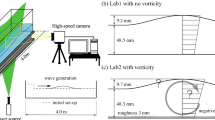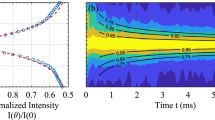Colliding dunes appear to traverse through one another and emerge unscathed.
Abstract
Barchan sand dunes are highly mobile, crescent-shaped dunes that occur in areas where sand is sparse and the wind is unidirectional. Here we show mathematically how two such loose-grained dunes are able to pass through one another while still preserving their shape. The crucial parameters for this solitary-wave behaviour, which is consistent with field observations, are the heights of the two colliding dunes.
This is a preview of subscription content, access via your institution
Access options
Subscribe to this journal
Receive 51 print issues and online access
$199.00 per year
only $3.90 per issue
Buy this article
- Purchase on Springer Link
- Instant access to full article PDF
Prices may be subject to local taxes which are calculated during checkout


Similar content being viewed by others
References
Bagnold, R. A. The Physics of Blown Sand and Desert Dunes (Methuen, London, 1941).
Finkel, H. J. J. Geol. 67, 614–647 (1959).
Hesp, P. A. & Hastings, K. Geomorphology 22, 193–204 (1998).
Sauermann, G., Rognon, P., Poliakov, A. & Herrmann, H. J. Geomorphology 36, 47–62 (2000).
Wippermann, F. K. & Gross, G. Boundary Layer Meteorol. 36, 319–334 (1986).
Werner, B. T. J. Geol. 98, 1–17 (1990).
Sauermann, G., Kroy, K. & Herrmann, H. J. Phys. Rev. E 64, 31305 (2001).
Kroy, K., Sauermann, G. & Herrmann, H. J. Phys. Rev. L. 68, 54301 (2002).
Hersen, P. et al. http://arxiv.org/abs/cond-mat/0303115 (2003).
Schwämmle, V. & Herrmann, H. Preprint http://arxiv.org/abs/cond-mat/0304695 (2003).
Lamb, G. L. Elements of Soliton Theory (Wiley, New York, 1980).
Besler, H. Z. Geomorphol. N.F. 126, 59–74 (2002).
Author information
Authors and Affiliations
Corresponding author
Ethics declarations
Competing interests
The authors declare no competing financial interests.
Rights and permissions
About this article
Cite this article
Schwämmle, V., Herrmann, H. Solitary wave behaviour of sand dunes. Nature 426, 619–620 (2003). https://doi.org/10.1038/426619a
Issue Date:
DOI: https://doi.org/10.1038/426619a
This article is cited by
-
Self-preserving characteristics in wall-wake flow downstream of an isolated bedform
Environmental Fluid Mechanics (2020)
-
Two improved displacement shallow water equations and their solitary wave solutions
Environmental Fluid Mechanics (2020)
-
On the stability of geotechnical systems and its fractal progressive loss
Acta Geotechnica (2017)
-
Simple stochastic cellular automaton model for starved beds and implications about formation of sand topographic features in terms of sand flux
Progress in Earth and Planetary Science (2016)
-
Evolution of downsized crescent-shaped dune in wind tunnel experiment
Science China Physics, Mechanics and Astronomy (2014)
Comments
By submitting a comment you agree to abide by our Terms and Community Guidelines. If you find something abusive or that does not comply with our terms or guidelines please flag it as inappropriate.



